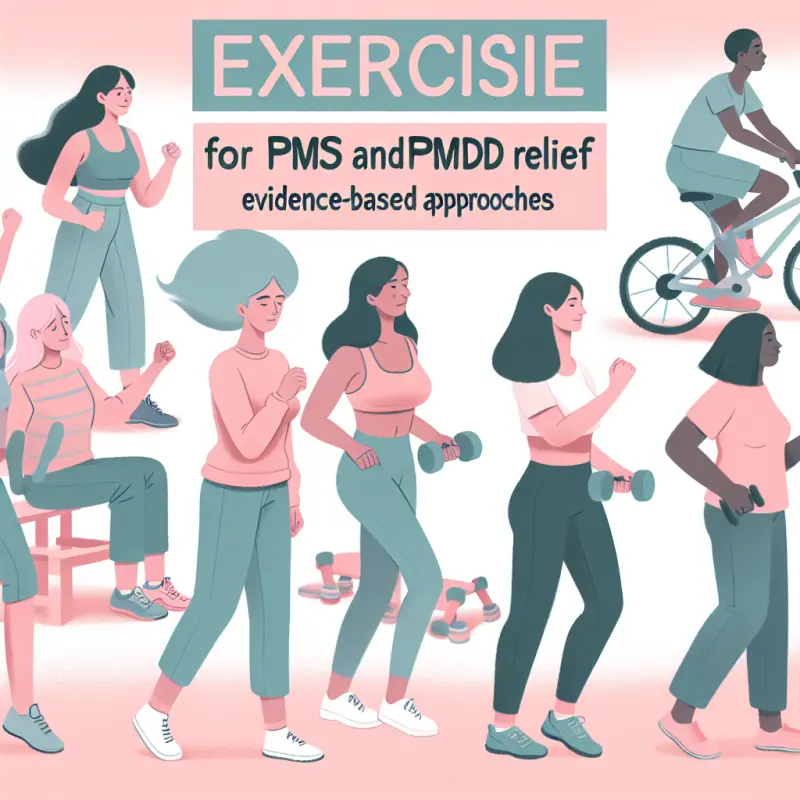Exercise for PMS and PMDD Relief: Evidence-Based Approaches

Exercise for PMS and PMDD Relief: Evidence-Based Approaches
Introduction
Premenstrual Syndrome (PMS) and Premenstrual Dysphoric Disorder (PMDD) are conditions that affect a significant portion of the female population, causing a range of physical and emotional symptoms. PMS is experienced by approximately 75% of menstruating women, while PMDD, a more severe form, affects about 3-8%. Symptoms can include mood swings, irritability, depression, anxiety, bloating, fatigue, and headaches, among others. These symptoms can significantly impact daily life, work, and relationships.
The quest for effective management strategies is ongoing, and exercise has emerged as a promising non-pharmacological approach. This article delves into the evidence supporting exercise as a tool for alleviating PMS and PMDD symptoms, examining the mechanisms behind its benefits, and providing practical recommendations for incorporating physical activity into daily routines.
Understanding PMS and PMDD
What are PMS and PMDD?
- PMS is characterized by a combination of emotional and physical symptoms that occur in the luteal phase of the menstrual cycle (after ovulation and before menstruation).
- PMDD is a severe form of PMS that includes emotional and behavioral symptoms that can interfere with daily functioning.
Symptoms
- PMS: Bloating, breast tenderness, mood swings, irritability, fatigue, changes in sleep and appetite, and headaches.
- PMDD: Severe depression, anxiety, tension, marked mood swings, irritability, and trouble concentrating.
The Role of Exercise in Managing PMS and PMDD
How Exercise Helps
Exercise is known to have numerous physical and mental health benefits, which can specifically target the symptoms of PMS and PMDD. The following mechanisms illustrate how exercise can be beneficial:
- Endorphin Release: Exercise stimulates the production of endorphins, which are natural mood lifters.
- Stress Reduction: Physical activity can lower the levels of stress hormones, such as cortisol, and promote relaxation.
- Improved Sleep: Regular exercise can enhance the quality of sleep, which is often disrupted during PMS and PMDD.
- Enhanced Mood: Exercise increases the production of neurotransmitters like serotonin and dopamine, which help regulate mood.
Evidence Supporting Exercise for PMS and PMDD
Several studies have highlighted the positive impact of exercise on PMS and PMDD symptoms:
- A study published in the Journal of Women's Health found that women who engaged in regular aerobic exercise reported fewer PMS symptoms compared to those who were sedentary.
- Research in the Journal of Obstetrics and Gynecology indicated that both aerobic and resistance training could reduce the severity of PMDD symptoms.
- A meta-analysis in the Journal of Affective Disorders concluded that exercise could be a viable intervention for reducing depressive symptoms associated with PMS and PMDD.
Types of Exercise for Symptom Relief
Aerobic Exercise
- Benefits: Improves cardiovascular health, increases endorphin levels, and reduces fatigue.
- Examples: Walking, jogging, cycling, swimming, and dancing.
- Recommendation: Aim for at least 150 minutes of moderate-intensity aerobic activity per week.
Strength Training
- Benefits: Enhances muscle strength, boosts metabolism, and improves body composition.
- Examples: Weightlifting, resistance band exercises, and bodyweight exercises.
- Recommendation: Incorporate strength training exercises at least twice a week.
Yoga and Pilates
- Benefits: Improve flexibility, balance, and core strength; promote relaxation and stress reduction.
- Examples: Hatha yoga, Vinyasa yoga, and Pilates mat exercises.
- Recommendation: Practice yoga or Pilates 2-3 times a week for optimal benefits.
Mind-Body Exercises
- Benefits: Focus on the connection between the mind and body, enhancing mental clarity and reducing stress.
- Examples: Tai Chi and Qigong.
- Recommendation: Engage in these exercises several times a week to enhance mental and physical well-being.
Practical Tips for Implementing an Exercise Routine
Set Realistic Goals
- Start with manageable goals and gradually increase the intensity and duration of workouts.
- Keep a journal to track progress and identify patterns in symptom improvement.
Find Activities You Enjoy
- Choose exercises that are enjoyable to increase adherence to the routine.
- Mix different types of exercises to keep workouts interesting and prevent boredom.
Listen to Your Body
- Pay attention to how your body responds to different exercises, especially during the luteal phase.
- Modify workouts based on energy levels and symptoms.
Incorporate Flexibility and Rest
- Include flexibility exercises like stretching to prevent injury and improve mobility.
- Ensure adequate rest and recovery days to prevent overtraining and fatigue.
Overcoming Barriers to Exercise
Lack of Time
- Schedule workouts as part of your daily routine, like an appointment.
- Opt for shorter, high-intensity workouts if time is limited.
Motivation Challenges
- Find a workout buddy or join group classes for motivation and accountability.
- Set small, achievable goals and reward yourself for reaching milestones.
Physical Discomfort
- Choose low-impact exercises if experiencing physical discomfort.
- Consult a healthcare professional if symptoms persist despite modifications.
Conclusion
Exercise is a powerful tool for managing the symptoms of PMS and PMDD, offering a natural and effective approach to improving physical and mental well-being. By understanding the benefits and incorporating a balanced exercise routine into daily life, women can experience significant relief from the debilitating symptoms associated with these conditions.
By setting realistic goals, choosing enjoyable activities, and listening to their bodies, women can harness the therapeutic potential of exercise. As research continues to uncover the nuanced relationship between physical activity and hormonal health, exercise remains a cornerstone of holistic health strategies for PMS and PMDD relief.